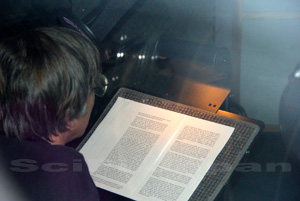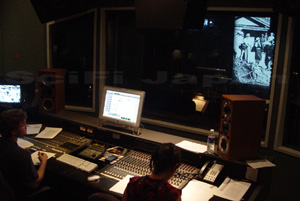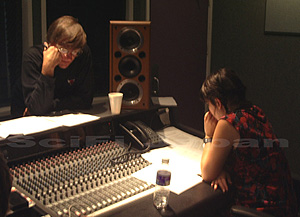Author: Ed Godziszewski
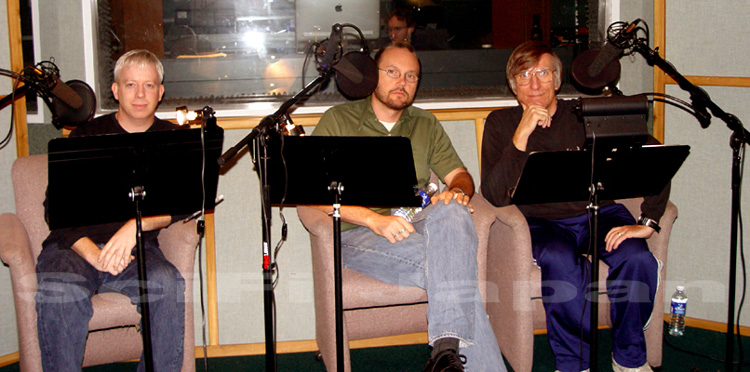 Keith Aiken, Steve Ryfle and Ed Godziszewski provide audio commentary for BFI`s GODZILLA 54 DVD. Photo courtesy of Caroline Millar.
Keith Aiken, Steve Ryfle and Ed Godziszewski provide audio commentary for BFI`s GODZILLA 54 DVD. Photo courtesy of Caroline Millar.A SciFi JAPAN EXCLUSIVE
I would always joke with my friends about how great it would be to have a job like a sportscaster or someone doing film analysis—to just talk about the subjects which you enjoy so much and get paid for it. But never would I have imagined that I would ever have the opportunity to do that very thing, especially when it came to a professionally produced product involving Godzilla, one of my passions. Being neither a professional nor a particularly accomplished public speaker, I figured my chances of ever contributing commentary to a DVD release were next to none. And Toho video releases outside of Japan have always been bare bones, whether it be due to Toho’s instructions or lack of interest on the part of releasing countries. So how in the world did the original GODZILLA ever get a DVD release outside of Japan with extras and commentary, much less with someone like me being involved?
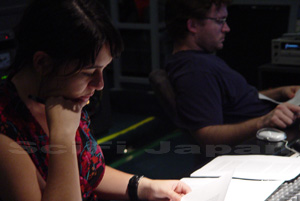 Caroline Millar and Andy the Sound Engineer prepare to record the audio commentary for BFI`s DVD release of GODZILLA 54. Photo courtesy of Ed Godziszewski.
Caroline Millar and Andy the Sound Engineer prepare to record the audio commentary for BFI`s DVD release of GODZILLA 54. Photo courtesy of Ed Godziszewski.As fans of Godzilla, we can all be thankful to Bruce Goldstein of Rialto Pictures for picking up the original GODZILLA and releasing it theatrically for the 50th anniversary in 2004. But I also owe him a debt of gratitude for mentioning the names of Steve Ryfle, Keith Aiken, and myself to Caroline Millar of the British Film Institute. Caroline had been in New York to get advice from Bruce about the BFI’s upcoming theatrical release of GODZILLA 54, and in thinking ahead to the eventual DVD release, she also asked about possible sources for commentary. Bruce gave our names to Caroline, one thing led to another, and before you know it, we were asked if we were interested in providing a commentary for the DVD release. A dream come true, though I must admit to a healthy dose of skepticism as to whether it would really happen since Toho’s track record in allowing these kinds of things was not so good. Caroline did not have any preconceptions about dealing with Toho and she succeeded in not only securing approval for the commentary but also for images to be used in a booklet and for several additional features, which I proposed. The moment of truth would be October 25, 2005 in the Marc Graue Recording Studio in Burbank…
One condition, which Toho insisted on was that a script of the commentary be submitted to them for approval. This turned out to be one of the best things that happened to us. Initially I had thought that it would be no trouble for the three of us to sit through the film and fill up the time with conversation and anecdotes about the movie, so at worst we would just need a topic outline and we could wing it from there. Because I had two business trips to Japan scheduled for the 3 months leading up to the recording, Steve volunteered to do the basic script, and being an excellent writer in his own regard, I knew he would do a fine job. So I provided Steve with a lot of the text from my Japanese Giants feature on the film, a few other notes I had, and a list of some stories I felt were especially worthwhile to tell during the course of the commentary. Steve did a great job in distilling all the material into a basic script, making it a good balance between production information and film commentary. Reviewing the first draft, I quickly understood the merits of having a script. While it would be easy to just talk about the film, it would be just as easy to overlook important subjects by getting lost in the moment and running out of time, and it was also vital that certain comments be timed to images on screen. The script gave us focus and allowed us to be sure that we did not overlook any of the most important topics on which we wanted to expound. Separately, I prepared detailed scripts and slide shows for the two supplemental features, which I had proposed, to Caroline.
I arrived in LA two days before the recording would begin and Steve and I spent most of the time refining the scripts, talking about our basic approach, and then assigning sections of the script for each of us so that we wouldn’t fall into the trap of talking over each other. As a basic approach, we both agreed that we needed to make the commentary accessible to anyone, not just hard core fans. So while we did include tidbits to please the fans, it was also important to give the uninitiated a sufficient context of the times and to do more general film comment. It was at this point that we concluded that some sections of the script, while important to relate, were best left to the supplements where they could be more fully developed. The night before recording, the three of us gathered together and made a dry run through the script as the film played on my computer. While it turned out to be a marathon session, we found where the script was too long or where holes existed, and it gave us the time to get a feel for working with each other and creating a more natural sounding flow to the whole thing. Lots of last minute revisions were made and printed on Steve’s uncooperative printer, and the moment of truth was upon us. Marc Graue Studios is a small recording studio, which does a lot of post dubbing work, much of it in animation. We walked down the hall the studio, walls covered with photos and autographs of stars and voice talent. The studio was loaded with high tech equipment, at the heart of which was a Macintosh computer (of course!) for recording and editing. After about a half hour of setup and sound tests, the film rolled and we were underway. The first hour or so of recording was mostly spent trying to shake out all the bugs… some technical glitches, nervous mistakes on our part, learning how to turn pages without having the sound picked up during dialog, and so on. We got a crash course in voice over work, how to recover from mistakes. The biggest challenge was to make it seem like we were not working from a script. By making it sound more conversational, it could be more accessible to the listener (well, at least that was our intention). If it were to sound like a lecture, that would be the surest way to turn off most listeners. The number of retakes quickly dropped, and we started to hit our stride in the film’s middle section. The first day’s recording finished during the middle of Godzilla’s attack on Tokyo, probably the most problematic section in that there was so much to say and very little time.
That night was filled with more revisions and Steve also worked hard on fleshing out some comments for the final section of the film, which was a bit thin in our first version, while I tried tightening up the supplemental features. Steve wrote some superb and insightful comments for this section, all the more impressive since it was done under such a tight deadline. By the time we hit the studio on Day 2, we were plenty tired but well prepared for wrapping things up. We started with a few retakes of Day 1 material which were mandated by technical problems, and then we went straight into the film, finishing the last part in reasonably short order. Next came the recording of the supplemental features, which we felt would be best done by just one person. Unfortunately, all the talking from the regular sessions and lack of sleep started to take its toll on my voice, so the supplements were recorded in sections, allowing my voice to recover at regular intervals. It also took a little time to mentally switch gears from the commentary to the more documentary-type narration that these features needed. Listening to my own voice played back in the studio as we evaluated each section for retakes was rather surreal…normally I am uncomfortable listening to a recording of my voice, but somehow the miracles of technology made it sound bearable. After finishing up with the supplements, we still had some extra studio time, so we decided to replay the Tokyo attack and offer some ad lib commentary. It was at this time that I fully recognized the merits of having the script for our guideline. While we were not at a loss for comments to make, it was easy to stumble or lose focus as you tried to react and compose thoughts in your head. Nevertheless, we were all much more relaxed and generally enjoyed speaking during this part.
After the whole thing was finished, I was left with the overwhelming feeling that, while I enjoyed doing this tremendously, it was also much more work than I had expected, both physically and mentally. But it was also very exciting to have been able to contribute to such a project, and it was a great pleasure to do so together with my friends. I can only hope that fans and non-fans alike will enjoy the commentary and special features, and am thrilled that I could be a part of it. I was actually still a bit apprehensive that something would happen to prevent the DVD from coming out, even after we finished the recording…as if fate would cruelly step in and take away this special experience. But here it is…the disc has actually been released, and kudos to Caroline and the BFI for a job well done and for making this possible. As a final bonus, BFI offered us a modest fee for doing the commentary, but honestly speaking, I would have paid them for the chance to do this.


